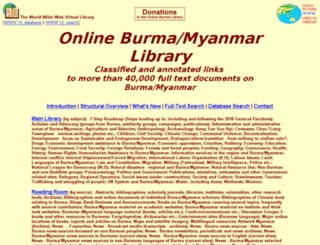Focal point
Location
The Online Burma/Myanmar Library (OBL) is a non-profit online research library mainly in English and Burmese serving academics, activists, diplomats, NGOs, CSOs, CBOs and other Burmese and international actors. It is also, of course, open to the general public. Though we provide lists of Burma/Myanmar news sources, the Library’s main content is not news but in-depth articles, reports, laws, videos and links to other websites, We provide a search engine (database and full text) and an alphabetical list of categories and sub-categories, but the Library is best accessed through browsing the 100 or so categories which lead to sub- and sub-sub categories. These tools should be used in combination.
Members:
Resources
Displaying 311 - 315 of 1151"Global Trends Forced: Displacement in 2014"
Global forced displacement has seen accelerated growth in 2014,
once again reaching unprecedented levels. The year saw the highest
displacement on record. By end-2014, 59.5 million individuals
were forcibly displaced worldwide as a result of persecution, conflict,
generalized violence, or human rights violations. This is 8.3 million
persons more than the year before (51.2 million) and the highest
annual increase in a single year.
Unleashing the potential of community forest enterprises in Myanmar
... Unleashing the potential of community forest (CF) enterprise in Myanmar is crucial for two main reasons. First, it will increase local incomes and government revenues, which will reduce poverty. Second, the financial incentive of such enterprises will encourage local people to manage and restore forests. Without enlisting the help of rural communities in these efforts it is likely that forest loss will continue and the contribution of forests to the rural economy will continue to decline.
Myanmar's Rosewood Crisis: Why Key Species and Forest Must be Protected Through CITES
... Extremely rapid growth in Chinese imports of ‘redwood’, ‘rosewoods’ or ‘Hongmu’ timbers from Myanmar in the past two years is directly driving increased illegal and unsustainable logging, posing a real threat to governance, the rule of law and the viability Myanmar’s dwindling forests. EIA research shows that, based on current trends, the two most targeted Hongmu species in
Myanmar - tamalan and padauk - could be logged to commercial extinction in as little as three years.
Mediating forest conflicts in South East Asia: Getting the positive out of conflicts over forests and land
Executive summary: "The high incidence of forest conflict in Southeast Asia underscores the need for conflict-transformation tools to maximize
the positive impacts and reduce potential damage. Mediation is considered one of the most effective approaches in
transforming conflict over natural resources. Mediation is often chosen when negotiation between conflict parties fails due
to the complexity and intensity of the conflict and because of unequal negotiating power. It is also chosen when the judicial
Agrarian Transitions in Two Agroecosystems of Kayah State, Myanmar
... Located on Myanmar’s eastern border with Thailand, Kayah State has long been isolated because of conflicts between the minority groups there and the Burmese army; as a result, little is known about its agricultural systems. As a preliminary to NGO agricultural development projects, an agrarian diagnosis of two major types of agroecosystems in the state—lowlands alluvial plains and uplands—was conducted. The objective was to identify recent agrarian changes leading to the current presence of different types of farmers in each area and understand their development potential.


